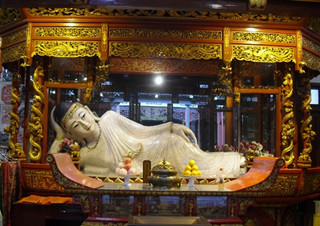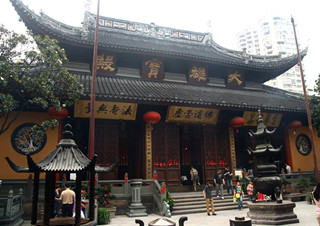- 86-15907880780
- contact@youngchinatravel.com
Most people travel out to Yufo Si Temple to see its two  charming jade Buddhas. When they arrive though, visitors are thunderstruck by this huge 7,737 square meter architectural complex, complete with Song Dynasty style.
charming jade Buddhas. When they arrive though, visitors are thunderstruck by this huge 7,737 square meter architectural complex, complete with Song Dynasty style.
Walking past the temple's Great Emperor Hall, will take you by the Precious Hall of the Great Hero, the Jade Buddha Building, halls on both sides devoted to "Guanyin", the Goddess of Mercy, the Copper Buddha Hall, the Reclining Buddha Temple, the Temple of Benevolence Hall, the meditation room and refectory. Climbing up to the second floor of the Jade Buddha Building will take you to see the first of the famed Jade Buddha statues. The second is located in the Reclining Buddha Temple.
The statue on the second floor of the Jade Buddha Building is known as the "treasure of town and temple". A representation of the seated Siddhartha Guatama (founder of Buddhism), at only 1.95 meters tall, the statue is not particularly large. Only one single giant piece of jade was needed to carve almost the entire statue you see here. Fringes of the jade Buddha's kasaya, or Buddhist monk coat, and the bracelet on his right arm are decorated with a hundred small pieces of jadeite, agate, and other precious stones. Sitting crosslegged, the Buddha's left hand rests on his left leg, and his palm faces upwards denoting the tranquility and concentration of his meditation. His right hand falls naturally at his side, fingers touching the ground, in a position called "touching earth". This slight gesture is rich in meaning, indicating that only the Earth can testify to all of Buddha's benevolent acts and his contributions to all creatures. Sending off a sparkling crystal-clear luster, the Buddha's eyes are half open and his lips are closed in composed serenity with a slight temperate smile. No matter from what angle you view him, he is always serenely and attentively watching you.
The Reclining Buddha Temple statue depicts the Buddha, Siddhartha Guatama, posed, naturally, in a reclining position. Called, "Siddhartha Guatama Obtains Nirvana," this statue portrays the eighty year old Siddhartha as he achieves parinirvana (the highest state of Buddhism) under two Sal trees in the outskirts of the Kushinagar. Intricately carved from a single large piece of white marble, the Buddha's right hand supports his head as he lies on a couch of mahogany wood. His face reveals a slight smile of peace and tranquility.
Yufo Si Temple owes its existence to these two Buddhist statues. During the eighth year of Qing Emperor Guangxu, Master Huigen of Putuo Mountain, set off on a journey through the Wutai and Emei Mountians on his way to Tibet. From Tibet, Huigen continued on to India and Myanmar. In Myanmar he came upon a mountain with a quarry of beautiful jade. With the support of the Myanmar King and the local Chinese Burmese people, Huigen cut a large amount of jade out of the quarry and hired skilled Tibetan craftsmen to have it meticulously cut and polished. When their work was finished Huigen was left with a total of five jade statues. Seven years later, Huigen returned from Myanmar to Putuo Mountain. He had the statues shipped inland by river and as a result, was forced to pass through Shanghai. At the time, the Shanghai investment bureau did not have a boat with an attached crane, and they were unable to continue this shipment of over one ton of jade. The father of Qing Dynasty railway minister, Sheng Xuanhuai, was at the scene, and earnestly requested that Huigen leave the Jade behind. Huigen relented, leaving behind two statues, and the Yufo Si temple was constructed to accommodate them.
Once you have seen the jade Buddhas, the temple's other precious artifacts are worth visiting.
artifacts are worth visiting.
The Precious Hall of the Great Hero has an ancient bronze statue of the standing Siddhartha Guatama Buddha cast in 491 AD during the reign of Northern Wei Dynasty Emperor Taihe, and a stone sculpture of the Medicine Buddha carved in 543 AD, the first year of Eastern Wei Dynasty Emperor Wuding. Both sculptures are subdued in composition, but created with great artistry. A Ming Dynasty statue of the Goddess of Mercy, cast in copper, sits in the Guanyin Goddess of Mercy Hall, and a Ming Dynasty bronze Amitabha Buddhist statue can be found in the Copper Buddha Hall.
Yufo Si Temple was moved from its original location in 1918, when Zen monk, Master Ke Cheng, built a new temple on Anyuan Lu. Yufo Si Temple Abbot, Master Yuanjian, founded the Shanghai School of Buddhism inside this new temple in 1942.
Today, the Jade Buddha Temple remains an essential stop for Shanghai visitors who desire to bum incense and pray. Included among the countless numbers of temple visitors are former United States presidential first lady, Nancy Regan, Britain's Princess Marguerite, Former French Prime Minister Pierre Mauroy, the Governor General Sir Ninian Stephen of Australia, the Governor Generals of Hong Kong and Macau, and eminent monks from Hong Kong, Macau, Taiwan, and all over the world. This is a place where people from all over the Buddhist world can come together despite differences in language and race. Magnificent smiles abound at Yufo Si, making the temple feel somewhat like heaven.
| Chinese Name: | 玉佛寺 |
|---|---|
| Address: |
No. 170 Anyuan Lu , Putuo District, Shanghai 普陀区安远路170号 |
| Ticket Price: | RMB 20 |
| Opening Hours: | 8am-16:30pm; Buddhist practitioners come here to pray and bum incense on the first and fifteenth days of the Lunar Calendar. On those two days, the temple is open from 5:30-16:30. |
| Recommended Time for a Visit: | 1h |
| How to Get: | To get there, you can take bus lines 13,19,24,36,54,63,68,76,105,106,112,113,138,206,223,506,516,550,563, 738,768,830,837,866, and 922. |
| Food and drink: | The Yufo Si Temple Vegetarian Restaurant can be found on the eastern side of the Buddhist supply shop. Their vegetarian fare has a long history and is well known in Shanghai. Prices here are also reasonable. Expect to pay about 30RMB per person. You can also buy vegetarian snacks here. Their Jingsu Moon cakes are a classic. Made with expert care and attention to every detail, the moon cakes have a crisp shell and fruit and nut fillings. These exquisite treats are famous all over Shanghai. |